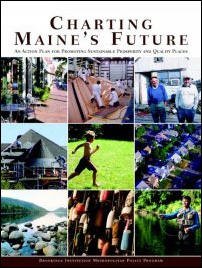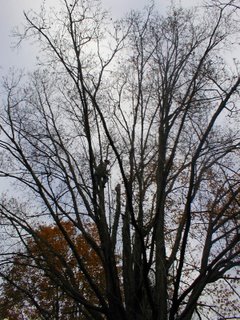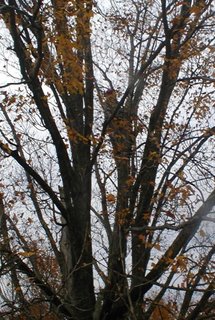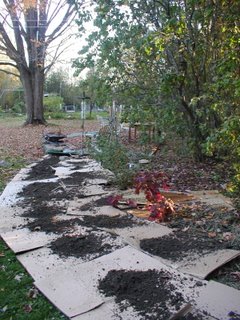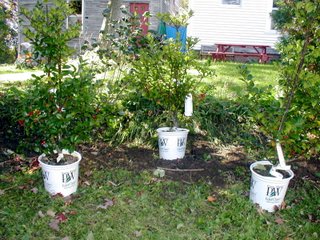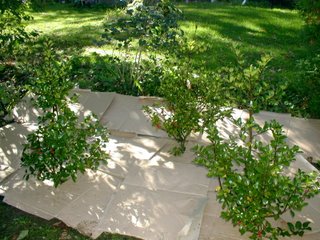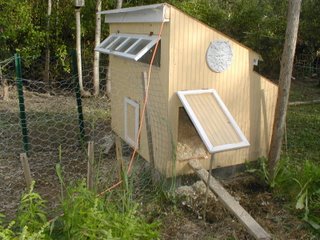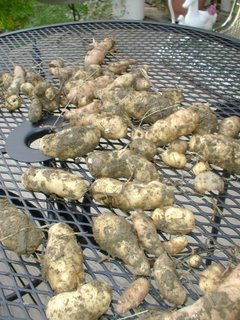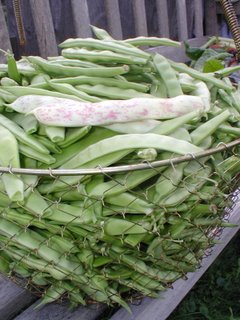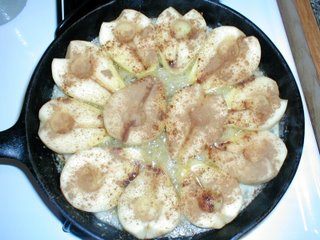 We had the maple tree cabled just in time. For the second weekend in a row, we had rain and strong gusty winds, with a power outage lasting several hours. All over town there's evidence of downed limbs and trees, but our beloved maple is still intact.
We had the maple tree cabled just in time. For the second weekend in a row, we had rain and strong gusty winds, with a power outage lasting several hours. All over town there's evidence of downed limbs and trees, but our beloved maple is still intact.Today's outage on our street was caused by an old maple tree on the next street over. The tree lost a big limb, which came down atop the power lines and knocked down a pole. I was in the middle of making a caramelized pear tart. I had finished cooking the pear filling, but had yet to make the crust, and then bake the tart. I was making it to take to dinner with our friends Karen and Bill.
My gas range still performs fine without electricity, but the oven has an electronic temperature control and ignition, so no baking without electricity. With the power out, I left the tart to cool and internally rubbed my hands gleefully in the realization I might as well read, as the vacuum cleaner was not working either. I puttered about and never did settle in to read before the power came back on, a few minutes after 4 o'clock. I was able to make a crust and bake the tart, which came out of the oven just 15 minutes before we were supposed to leave for Karen's house.
We made a quick stop on the way to buy some lottery tickets for them; we were already lucky to be invited to dinner, where Karen was making her famous pressed sandwiches, so we decided we should pass on the luck.
The sandwiches were, as always, fabulous (ham and bacon with honey mustard, red onion, portabello mushrooms, muenster and avocado spread, wow), and we enjoyed a good evening of cards and laughter as the wind howled and the rain drummed on the roof.
CARAMELIZED PEAR TART
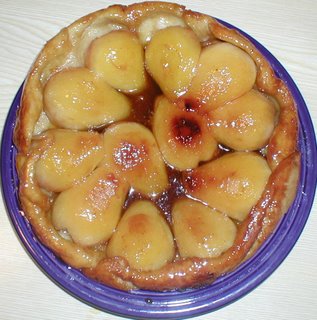
This fabulous dessert makes the end of summer and the arrival of pear season more bearable. It is easy, delicious and looks exceptionally glamorous.
4 large firm-ripe Bosc pears (2 lb total) *
1/2 stick unsalted butter
1/2 cup sugar
1/2 teaspoon cinnamon
Pastry dough
Peel and halve pears, then core (a spoon or melon baller works well for this). Heat butter in a 9- to 10-inch well-seasoned cast-iron skillet over moderate heat until foam subsides, then stir in sugar (sugar will not be dissolved). Arrange pears, cut sides up, in skillet with wide parts at rim of skillet. Sprinkle pears with cinnamon and cook, undisturbed, until sugar turns a deep golden caramel. (This can take as little as 10 minutes or as much as 25, depending on pears, skillets, and stove.) Cool pears completely in skillet. (This part can be done early in the day.)
Preheat oven to 425°F.
Roll out dough on a lightly floured surface with a floured rolling pin into a 12-inch round and trim to a 9 1/2- to 10 1/2-inch round. Arrange pastry over caramelized pears, tucking edge around pears inside rim of skillet. Bake tart until pastry is golden brown, 30 to 35 minutes. Cool on rack 5 minutes.
Invert a rimmed serving plate (slightly larger than skillet) over skillet and, using pot holders to hold skillet and plate tightly together, invert tart onto plate. Serve tart warm or at room temperature.
*You can also substitute with tart apples, such as Pippins or Granny Smiths
1/2 cup (1 stick) plus 1 tablespoon unsalted butter, room temperature
1 1/2 cups sugar
11 medium-size Pippin apples (about 4 3/4 pounds), peeled, quartered, cored
Place the apples on their sides, as close together as possible. Follow the directions for the pear dish.
BUTTER PIE CRUST
Butter really does make the best pie crusts. The secret is keeping the dough cold and working it as little as possible.
Makes one 8” – 10” double crust pie.
2 1/2 c flour
1 t sugar
1/2 t salt
1 c (2 sticks) cold unsalted butter, grated
1/4 – 1/2 c ice water (fill a cup with water & add a few ice cubes; the colder the water the better)
Grate butter into food processor bowl. Add flour, sugar, and salt; blend in processor, using on/off turns, until coarse meal forms. 1/4 c water. Using on/off turns, blend just until moist clumps form, adding more water by 1/2 tablespoonfuls if dough is dry. Gather dough into ball; divide in half and flatten into 2 disks. Wrap in plastic; refrigerate at least 1 hour. If you can, chill the piecrust after rolling out and before baking.
